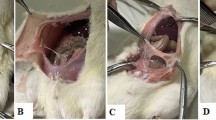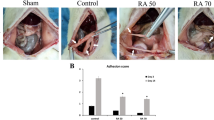Background
. Intraperitoneal adhesions remain a problem after abdominal surgery. Octreotide has been proved to be able to reduce the number, strength, and extent of fibrous bands at and away from the anastomotic site in an animal model of rats with intestinal resection and reanastomosis. The aim of the present study was to investigate whether epidermal growth factor receptor (EGF-R), tissue plasminogen activator (tPA), and plasminogen activator inhibitor (PAI) are involved in this process. Methods. Laparotomy with intestinal resection and reanastomosis was performed on 60 male Wistar rats. All rats were randomly assigned to five groups: receiving no medication (control; C), normal saline (NS), octreotide solution peritoneal irrigation (Oc), octreotide intramuscular injection (IM), and Oc plus octreotide intramuscular injection (Oc + IM). The concentrations of serum EGF-R, plasma tPA, PAI-1, and PAI-2, and the strength of wound healing were measured. Results. The serum EGF-R concentration showed no significant change from the preoperative level in the C and NS groups 7 and 14 days after the abdominal surgery. However, it decreased significantly on postoperative days 7 and 14 in groups Oc, IM, and Oc + IM (P < 0.05). The plasma tPA concentrations were significantly higher than the preoperative level in all groups of rats on postoperative day 7. The levels were higher in groups Oc, IM, and Oc + IM than in group C or group NS at that time (P < 0.05). On postoperative day 14, the plasma tPA concentrations had returned to the preoperative level in group C and group NS. However, the concentrations in groups Oc, IM, and Oc + IM still remained at a significantly higher level than the concentrations in group C and group NS. The plasma PAI-1 and PAI-2 concentrations showed no significant difference from the preoperative level in group C and group NS on days 7 and 14 after the abdominal surgery. However, the concentrations in groups Oc, IM, and Oc + IM on postoperative days 7 and 14 were markedly lower than those in groups C and NS (P < 0.05). The wound strength was significantly greater on day 14 than on day 7 in all groups. Conclusions. In the rats with octreotide irrigation, the EGF-R level was decreased, the plasma tPA concentration was higher, and the plasma PAI-1 and PAI-2 concentrations were lower when compared with values in group C and group NS rats on days 7 and 14 after surgery. The data suggest that EGF-R, tPA, PAI-1, and PAI-2 are all involved in the mechanism of octreotide's action in reducing adhesion formation.
Similar content being viewed by others
Author information
Authors and Affiliations
Additional information
Received: February 25, 2002 / Accepted: November 22, 2002
RID="*"
ID="*" Reprint requests to: H.-S. Lai
Acknowledgments. This study was supported by a National Science Council Grant (NSC87-2314-B-002-352), and a National Taiwan University Hospital Grant (NTUH. 89S1509)
Rights and permissions
About this article
Cite this article
Lai, HS., Chen, Y., Chang, KJ. et al. Effects of octreotide on epidermal growth factor receptor, tissue plasminogen activator, and plasminogen activator inhibitor during intraperitoneal adhesion formation. J Gastroenterol 38, 555–560 (2003). https://doi.org/10.1007/s00535-002-1103-6
Issue Date:
DOI: https://doi.org/10.1007/s00535-002-1103-6




